Modular infrastructure for verifiable DePIN
"Don't trust, verify." This famous quote precisely captures the core power of decentralization: users do not need to trust others, but can personally verify the authenticity and reliability of the blockchain state—such as the history of users, assets, and transactions.
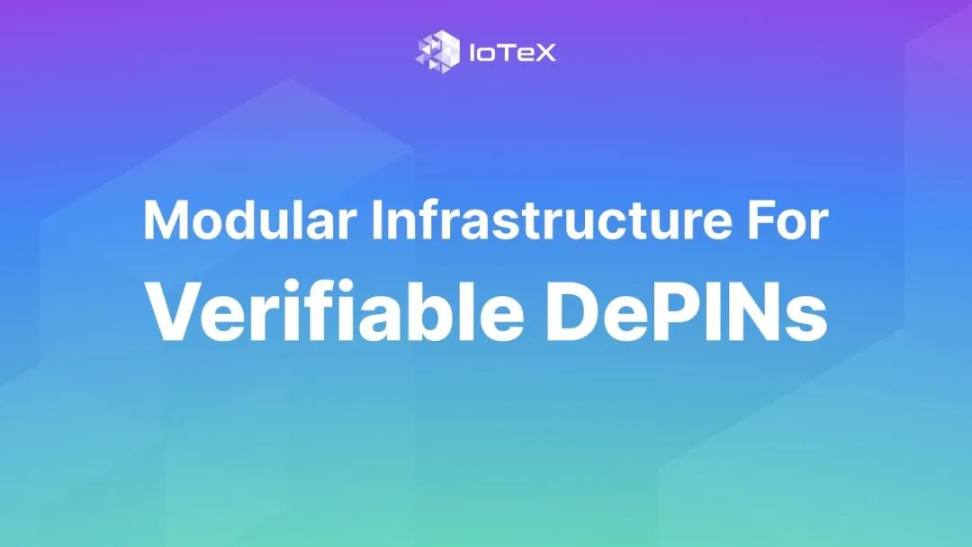
For DePIN, "off-chain" data and computation is not just a design choice, but a necessity. So, how can real-world events be verified and reliably recorded on-chain?
"Don't trust, verify." This famous saying precisely captures the core power of decentralization: users do not need to trust others, but can personally verify the authenticity and reliability of blockchain states (such as the history of users, assets, and transactions). This verifiability also applies to Dapps running on the blockchain, as long as their transactions and computations are conducted on-chain via smart contracts. However, many popular Dapps today (such as DeFi, GameFi) are not 100% on-chain in architecture, due to the high cost of on-chain computation, limited scalability, and the need to use off-chain data.
Therefore, many projects adopt a hybrid on-chain/off-chain architecture, executing complex computations related to real-world data off-chain and then uploading the results on-chain. However, off-chain activities do not naturally enjoy the same level of security and verifiability as on-chain operations, which brings additional challenges to the design of decentralized applications.
In the world of Decentralized Physical Infrastructure Networks (DePIN), user-owned hardware devices form data networks through blockchain protocols, already providing data, digital resources, and real-world services. For DePIN projects, using off-chain data and computation is not only inevitable but also the core of the value chain: their value comes from transforming real-world activities into digital insights, thereby driving the on-chain token economy.
However, while this connection between real-world activities and the blockchain opens up broad application scenarios for DePIN, it also brings unique challenges:
How can real-world events be verified before being recorded on-chain?
Since 2017, IoTeX has been leading innovation in the DePIN field, building modular infrastructure designed specifically for DePIN and defining verifiable connection standards between the real world and the blockchain. However, the current DePIN field still faces some worrying challenges: many projects, in order to go to market quickly, choose unverifiable centralized infrastructure, abandoning the long-term construction of verifiable decentralized infrastructure. This approach may weaken the sustainable development potential of DePIN projects.
We call on all participants in the DePIN sector—developers, users, investors—to jointly value and advocate for DePIN verifiability. This will not only promote the legitimacy and demand growth of DePIN, but also unlock huge potential in composability and interoperability.
In this blog, we will explore the importance of DePIN verifiability, analyze the infrastructure requirements for supporting verifiable DePIN, and showcase current and future application scenarios for verifiable DePIN.
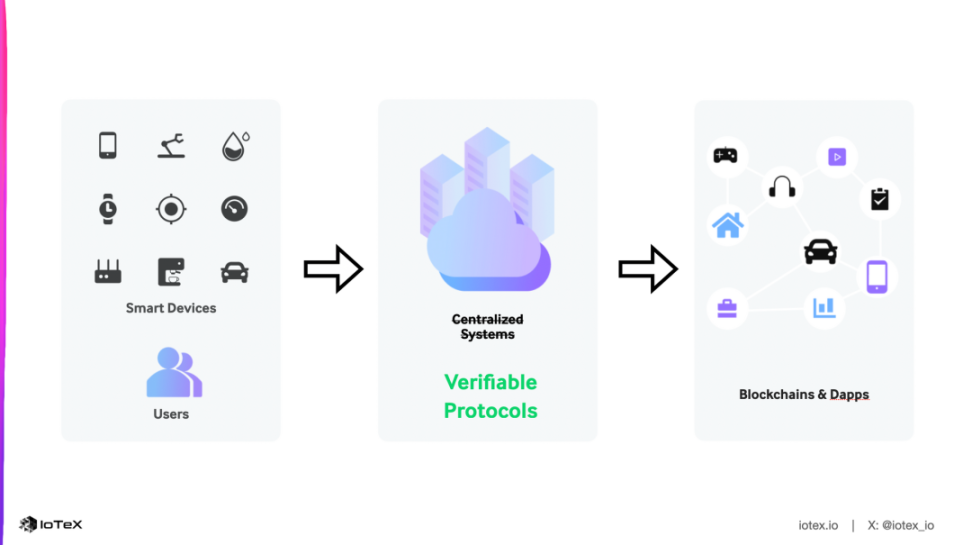
The Importance of DePIN Verifiability
In an increasingly digital world, whom and why we trust is more important than ever. When people build trust, the most important things to verify are:
Whether you are who you claim to be (i.e., identity)
Whether you are doing what you claim to be doing (i.e., utility)
A typical real-world scenario is a job interview—employers verify the applicant's identity through background checks, then assess their abilities through interviews. This basic verification of identity and utility forms the foundation of trust between people.
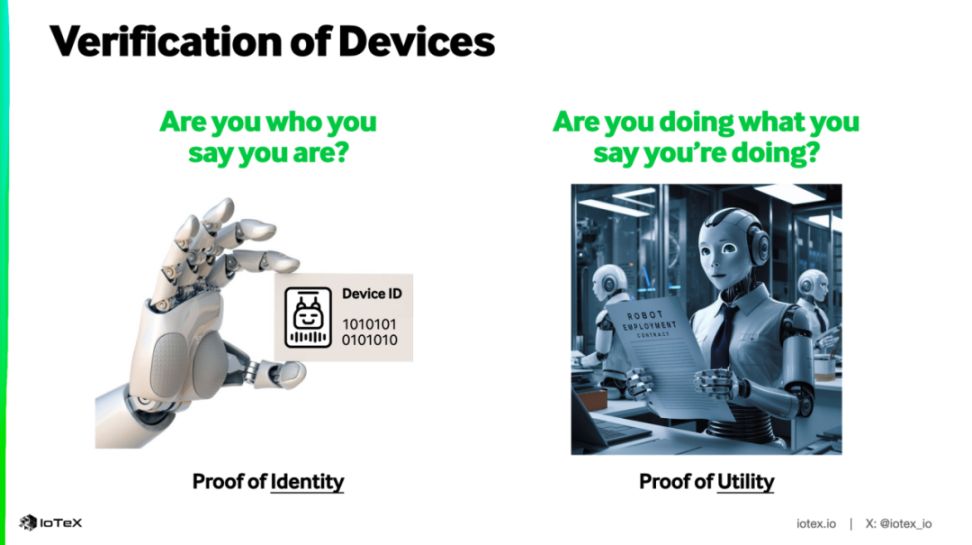
For DePIN, verifying the identity and utility of devices is equally crucial. Employees in a company are the "workers" who perform tasks, and devices in a DePIN network can also be seen as "workers." The identity and attributes of devices ("proof of identity/specifications") and their ability to perform tasks ("proof of work/utility") constitute the core elements of the DePIN supply side. Similar to the number of employees and products in a traditional company, the supply side of DePIN (i.e., the number of devices and service quality) directly affects its value and potential. Therefore, any consumer or enterprise (i.e., the "demand side") consuming DePIN data, resources, or services should be able to verify whether these device "workers" are trustworthy before transacting. This ability for the demand side to verify the identity and utility of device "workers" is critical for driving DePIN demand growth.
In addition to devices performing real-world tasks, the end-to-end process of DePIN also involves multiple modules, which together form the DePIN value chain. At a macro level, these modules are responsible for:
Processing outputs from DePIN devices (such as data, resources, services)
Computing "Proof of Real World Activity"
Uploading proofs to on-chain Dapps or smart contracts
Issuing token rewards to device owners on the blockchain
The end-to-end process may vary depending on the specific application scenario of DePIN, but usually involves the following types of data processing:
Data in-transit
Data at-rest
Data in-use
In addition to the need for verifiability of DePIN's physical devices in the real world, the servers and nodes throughout the value chain also need to be verifiable, because the trustworthiness of the value chain depends on the weakest link in the entire chain.
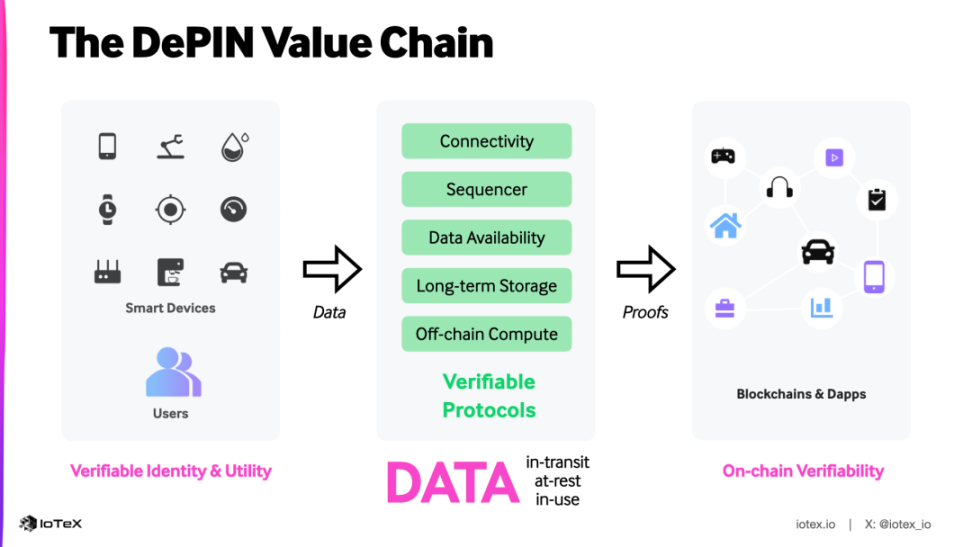
Now that we understand the key components of DePIN verification—device identity and utility, as well as data transmission, storage, and computation—let's explore the infrastructure needed to achieve end-to-end verifiability for DePIN.
Overview of DePIN Infrastructure
Infrastructure is the technological foundation upon which applications are built. Compared to other categories of Dapps (such as DeFi, NFT), DePIN projects require broader and more complex infrastructure, posing challenges for development teams in innovation, growth, and scaling. The main reason is that DePIN requires participation from real-world physical hardware and relies on information transmission, storage, and computation in the real world. In addition, existing DePIN networks are relatively isolated, lacking composability between modules, which limits innovation potential. To accelerate the rapid development of the DePIN sector, its infrastructure must adhere to three main principles: modularity, composability, and verifiability.
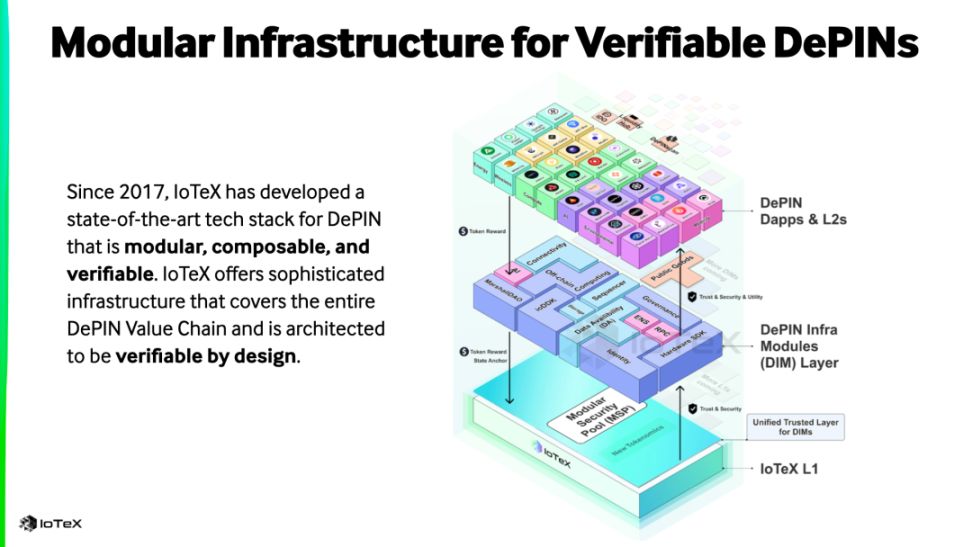
Modularity
DePIN systems should consist of functionally distinct, interchangeable modules, providing developers with greater flexibility and scalability. Modular design allows top protocols from various fields to be integrated into end-to-end solutions. Required DePIN modules include: device identity authentication, network connectivity, data ordering and storage, off-chain computation, etc., which work together to build a complete DePIN value chain.
Composability
DePIN systems should support seamless connection and interaction between modules, encouraging developers to innovate based on existing infrastructure. Although a single DePIN project may focus on a specific vertical (such as energy, transportation, network connectivity, etc.), they all rely on general-purpose horizontal infrastructure. Composability avoids the need for each project to repeatedly build basic modules, promotes collaboration among infrastructure providers, and forms an interconnected ecosystem.
Verifiability
DePIN systems should prioritize end-to-end verifiability, as the trustworthiness of the system depends on its weakest link. By adopting open-source and verifiable technologies (such as zero-knowledge proofs) and avoiding "black box" designs, infrastructure can be verifiable from the outset. This enables anyone to verify the activities and outputs of each module, and thus the reliability of the entire system. DePIN projects built on verifiable infrastructure do not need to repeat verification work and can focus on meeting the specific needs of their projects.
Over the past seven years, IoTeX has built an advanced modular, composable, and verifiable DePIN technology stack. This stack consists of IoTeX's internal modules (such as ioID for device identity authentication, ioConnect for data transmission, W3bstream for verifiable computation, and the L1 blockchain network for running smart contracts) and leading infrastructure partners (such as Streamr for connectivity, Espresso for data ordering, Nuffle for data availability, and Filecoin/Irys for storage services).
The IoTeX technology stack covers all aspects of the DePIN value chain and is verifiable by design, enabling DePIN developers to build their projects using the most advanced infrastructure on the market without the need for additional verification work.
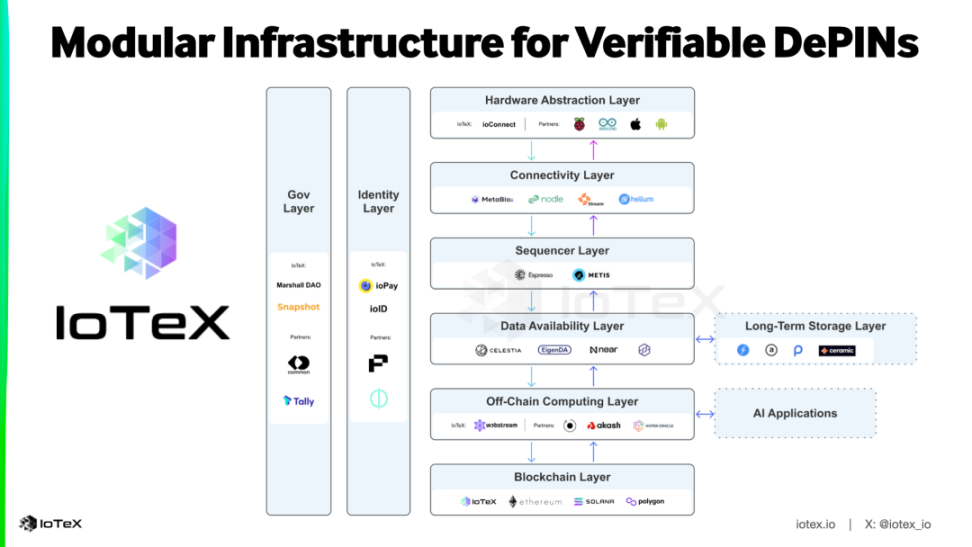
ioID and W3bstream: The Future of DePIN
Modular infrastructure is essential for developers to address the complexity of DePIN construction, lower the entry barrier, and find product-market fit more quickly. Among the many modules in the end-to-end DePIN technology stack, IoTeX will launch two revolutionary flagship products in November and December 2024: ioID and W3bstream, which will fundamentally transform the DePIN sector.
ioID: On-chain Identity Solution for Devices
ioID is the first on-chain identity solution that endows real-world physical devices with Decentralized Identity (DID) and Verifiable Credentials (VC), making physical devices on-chain entities. DePIN projects using ioID allow anyone to verify the identity of devices ("who you are"), ensuring the authenticity and trustworthiness of the DePIN supply side.
In addition, ioID also plays a key role in DePIN capital formation. Miners and community members can pre-purchase ioID through Initial Device Offering (IDO) to launch DePIN networks. Once a device is granted an on-chain DID, the DID can be bound to the device owner's on-chain identity, establishing ownership of the physical device. At the same time, after the device passes a series of challenge/response tests, the DID can also be granted verifiable credentials (such as identity, functionality, configuration, or certifications from manufacturers, regulators, and maintainers).
The $IOTX token will be used for the creation and management of ioID. Device owners need to burn and stake $IOTX to obtain ioID and register their devices on the IoTeX L1 blockchain.
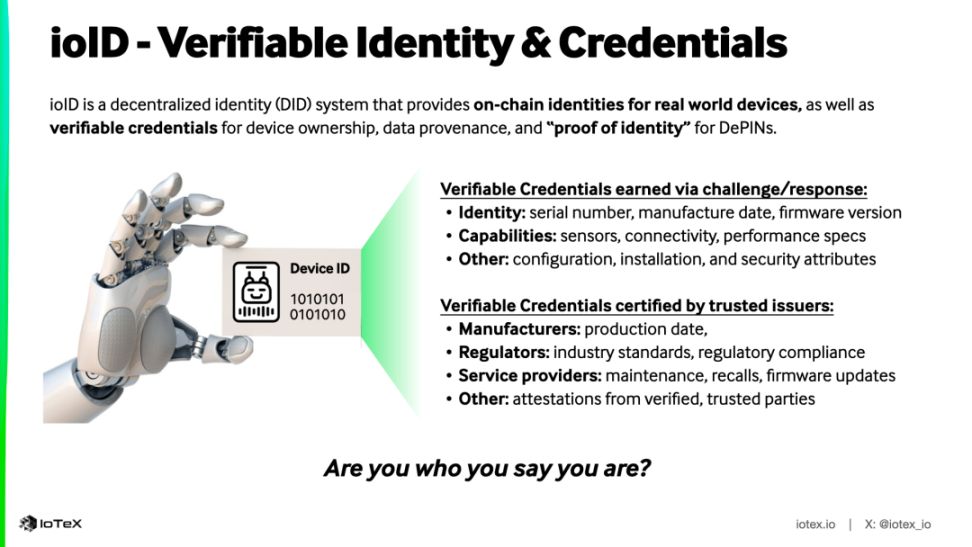
W3bstream: A Verifiable Computing System Tailored for DePIN
W3bstream is a verifiable computing system built specifically for DePIN, utilizing zero-knowledge proofs (ZKP) to verify the computation results of real-world data and metadata provided by devices. W3bstream is a permissionless, blockchain-agnostic computing engine that provides DePIN developers with composable infrastructure to prove whether devices are fulfilling their promised tasks.
For example, in renewable energy DePIN projects, W3bstream can receive data directly from solar panels or other energy devices and use ZKP to generate proofs of energy production, allowing anyone to independently verify the utility of each device and the entire DePIN. In addition, W3bstream will integrate with ioID, assigning verifiable credentials to ioID by processing zero-knowledge proofs, further verifying the identity of DePIN devices.
The $IOTX token is also integrated into the design of W3bstream. Node operators need to stake $IOTX, while DePIN project teams will drive W3bstream's economic model by consuming $IOTX.
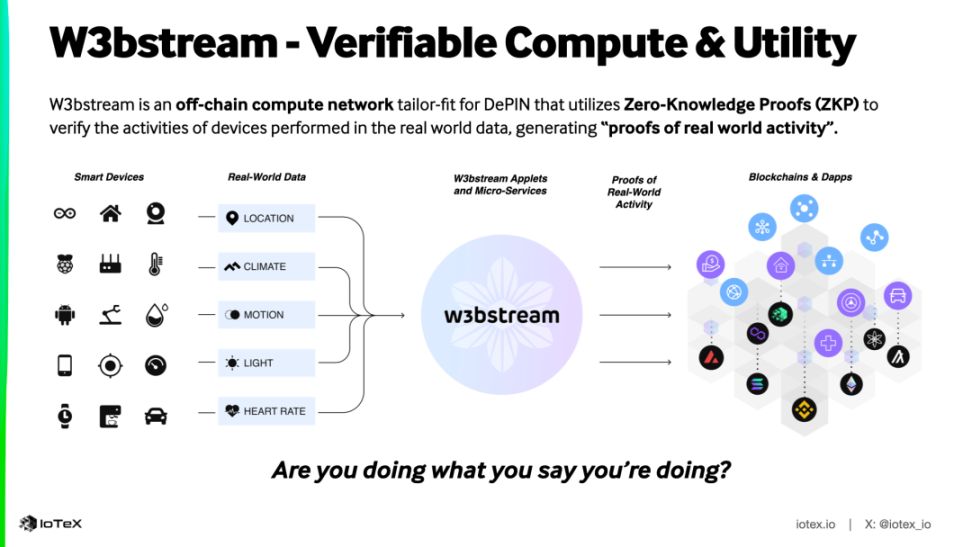
The launch of ioID and W3bstream marks a future of greater credibility and verifiability for DePIN, providing developers with advanced infrastructure and accelerating the comprehensive development and maturity of the DePIN ecosystem.
Application Scenarios for Verifiable DePIN
Although the DePIN sector has developed rapidly in recent years, a large amount of potential remains untapped due to the lack of verifiability. As of Q3 2024, millions of physical devices have "connected" to DePIN networks, but the vast majority of DePIN projects have failed to meet the needs of enterprises and mainstream consumers. The reason is simple—the supply side of current DePIN lacks verifiability and thus cannot gain the trust of users and enterprises outside the crypto community.
If data sources cannot be verified, AI model trainers will not use data generated by DePIN; enterprises will not adopt DePIN's digital resources (such as CPU, GPU, storage) unless their 24/7 availability can be verified; ordinary consumers will not use DePIN-provided services (such as ride-hailing, logistics delivery) if they cannot verify the success rate of these services.
Without verifiability on the supply side, there can be no growth on the demand side.
Application Scenario 1: Verifiability as Utility
Verifiability itself is the primary and most important application scenario for DePIN. DePIN practitioners must realize: the only way to address skepticism from non-crypto users is to prove that DePIN's utility is real and verifiable. DePIN projects that achieve verifiability will establish legitimacy and trust among multiple stakeholder groups:
Miners (Supply Side): Miners want to connect devices to real networks
End Users (Demand Side): End users want to consume genuine utility
Investors: Venture capital and retail investors need proof of supply-side growth and utility
Exchanges: CEXs need credible metrics to list tokens
Regulators: Compliance requires the ability to verify DePIN activities
Enterprises: Service Level Agreements (SLAs) depend on verifiable service delivery
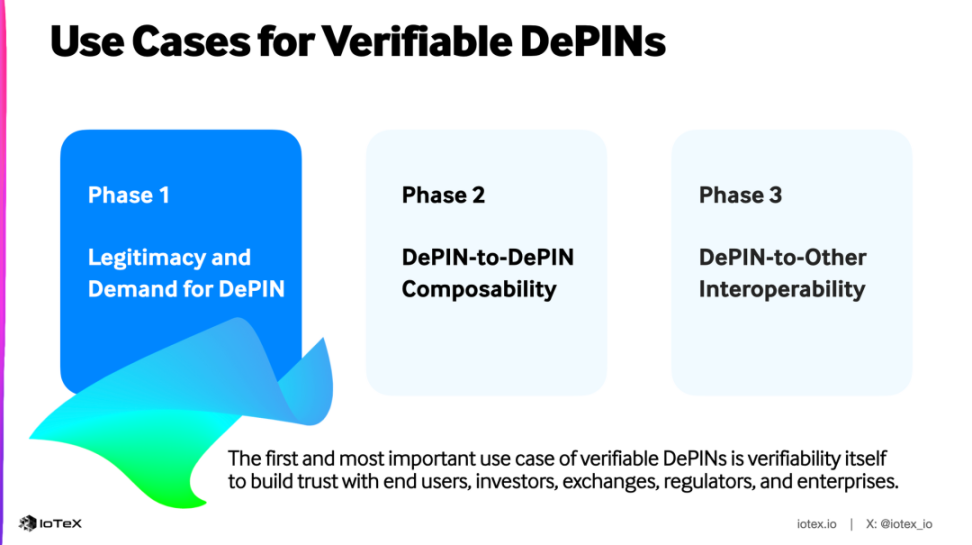
Application Scenario 2: Unlimited Potential Around Composability and Interoperability
Once DePIN achieves verifiability, it will unlock a series of application scenarios centered on composability and interoperability, greatly expanding the total addressable market (TAM) of the DePIN industry. Just as the composability of infrastructure modules facilitates seamless connection and interaction between modules, at the application layer, verifiable DePIN projects in different verticals or geographic regions can also achieve seamless, permissionless interoperability.
However, such interactions between DePIN projects are only feasible if all participating networks are verifiable, because DePIN projects should not blindly trust other projects and networks—the credibility of an interconnected DePIN system depends on its weakest link.
Composability Application Scenarios:
Cross-domain composition: Weather DePIN projects provide meteorological data to predict weather conditions, which affects the energy prices of renewable energy DePIN projects, then determines the number of electric vehicles dispatched by ride-hailing DePIN projects, and finally prompts smart city DePIN projects to provide more parking resources to support the expansion of the ride-hailing network.
Cross-regional composition: Network connectivity DePIN projects deploying hotspots in South America can provide network roaming services to travelers from other markets such as Africa and Southeast Asia, enabling DePIN projects originally limited to a certain region to serve global users.
Resource composition: DePIN projects providing digital resources such as data storage and GPU computing can aggregate resources with other suppliers to form a larger supply side and attract more market demand. This is similar to DEX aggregators in DeFi, which aggregate liquidity from multiple DEXs to provide users with a better trading experience.
Device composition: Devices with verifiable attributes or functions can participate in multiple DePIN projects simultaneously. For example, an all-in-one device with environmental sensors, 5G connectivity, and GPU can serve multiple DePIN projects at the same time, or a top-tier weather station can authorize its weather data to multiple weather DePIN projects. We call this capability "device abstraction."
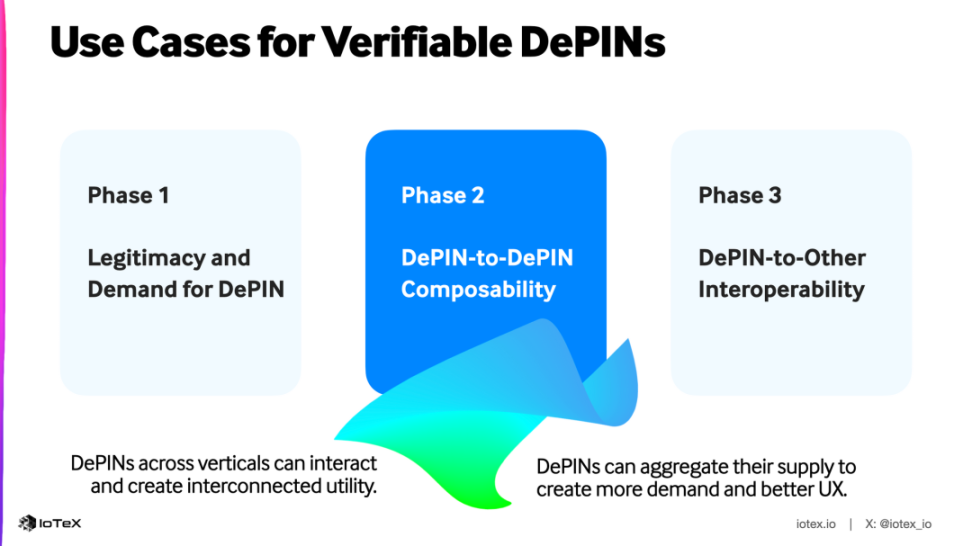
DePIN-to-DePIN composability will unlock new creative space for developers, enabling them to build interconnected services and products, integrate all DePIN projects into a composable system, and create new sources of revenue and demand for each project.However, the greater opportunity lies in interoperability between the DePIN sector and other industries, including Artificial Intelligence (AI), Decentralized Finance (DeFi), Real World Assets (RWA), and prediction markets.Interoperability between DePIN and these trillion-dollar markets will generate unimaginable network effects and make DePIN an indispensable part of the real economy.
Cross-industry Interoperability Application Scenarios:
As real-world activities are increasingly recorded on-chain, physical devices will generate massive amounts of sensor data, metadata, and other forms of data, which can be used to train AI models. However, if the data cannot be verified and is not trustworthy, it will be difficult to utilize effectively. By verifying the devices that generate the data and the quality of their data, DePIN data can be used in AI systems, creating new business value and accelerating the intelligence of the real world.
DePIN-to-DeFi
Data, services, and resources generated by DePIN networks can serve as inputs for various DeFi applications. Verifiable data from DePIN networks (such as weather data, camera footage, drone images) can support on-chain insurance markets. Verifiable resources generated by DePIN networks (such as GPU/CPU computing power, storage capacity, network bandwidth) can be tokenized as on-chain commodities and traded freely in the market like physical goods.
DePIN-to-RWA
DePIN devices that generate verifiable cash flows can be tokenized as tradable and lendable Real World Assets (RWA). Similar to fixed-income products, the principal value of DePIN devices and the fixed returns paid in cryptocurrency will become unique investment tools for investors and provide innovative financing channels for physical infrastructure deployers.
DePIN-to-Prediction Markets
DePIN devices can serve as "oracles," measuring real-world phenomena and providing verifiable insights for prediction markets. On-chain prediction markets can settle based on indicators measured by DePIN devices, such as weather, traffic flow, network speed, etc. DePIN will play an important role in future prediction markets.
By achieving DePIN-to-DePIN composability and cross-industry interoperability, the DePIN sector will unleash enormous market potential, accelerate its integration with other fields, and drive the emergence of new application scenarios and business models.
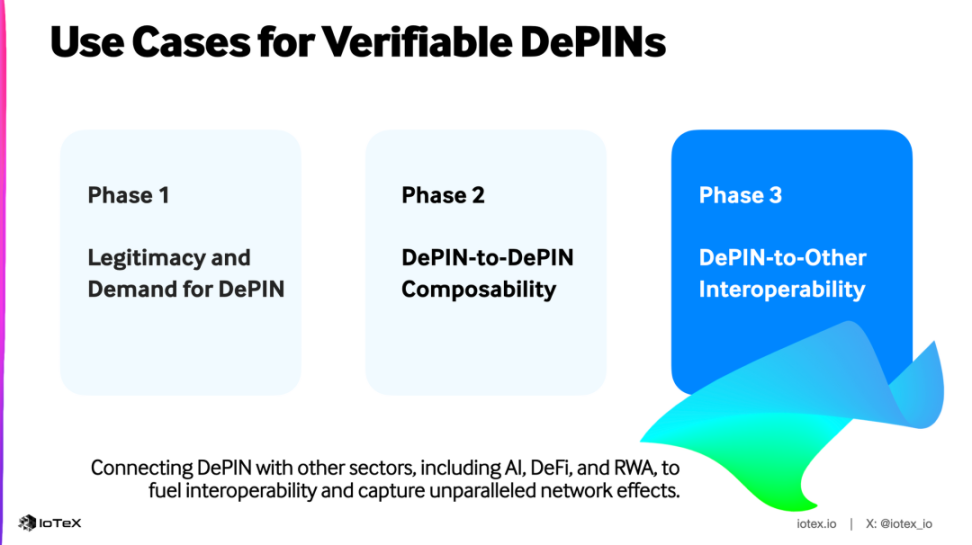
Conclusion
DePIN represents the future. As the DePIN industry develops rapidly, we must assess and reflect on its current state to ensure that the capital, time, and effort invested by all participants truly drive the ultimate goal of large-scale DePIN adoption. Innovation in the DePIN sector is booming, with new types of devices and new categories of projects emerging every day. This curiosity and growth-oriented mindset are key drivers of successful innovation, but we must also recognize that innovation must be combined with standards to stimulate real and sustainable market demand.
Verifiability is the next important frontier in the DePIN sector. IoTeX is working with all DePIN stakeholders to jointly set standards and drive the industry to new heights. Verifiability will not only enable the public to trust individual DePIN projects, but also promote composability between DePIN projects and drive interoperability between DePIN and other industries, opening up a new world of potential applications.
For more information on IoTeX's technology and vision for verifiable DePIN modular infrastructure, please visit:
IoTeX official website: https://iotex.io
Detailed technical documentation: http://docs.iotex.io
We look forward to building the future of DePIN with you!
About IoTeX
IoTeX is an open platform for modular construction of AI+DePIN infrastructure, aiming to bridge the connection between smart devices, real-world data, and Web3, enabling Web2 to conveniently and effectively access the blockchain, and creating a decentralized real-world open ecosystem with multidimensional data and scenarios. Through modular construction, developers can connect smart wearables, connected vehicles, green energy, environmental data, and more, from smart living to smart industry, for full-scenario innovative applications in Web3.
With the launch of W3bstream—the world's first zero-knowledge chain decentralized off-chain computing infrastructure designed for smart devices and real-world data—IoTeX has become a leading supplier of Decentralized Physical Infrastructure Network (DePIN) technology, building an open platform for full-scenario AI data stacks, enabling trusted and private interaction between machines, humans, enterprises, and dApps, and promoting innovation in AI and DePIN verticals.
Supported by more than 60 research scientists and engineers worldwide, IoTeX, through its high-performance EVM Layer 1, off-chain computing middleware, and open hardware platform, connects billions of smart devices, machines, and sensors, providing seamless integration and interaction for dApps in both the real and digital worlds, and driving the real world toward a decentralized open ecosystem.
Explore the IoTeX Ecosystem
Official website: https://iotex.io
Recommended Reading
IoTeX Ecosystem Panorama: In-depth Interpretation of the Explosive DePIN Ecosystem
IoTeX 2024 Q3 Major Events Review
Over 5,000 Registrations, Token2049's Largest DePIN Summit IoTeX "R3al World" Successfully Concluded
If you like IoTeX, click "Watching"
Disclaimer: The content of this article solely reflects the author's opinion and does not represent the platform in any capacity. This article is not intended to serve as a reference for making investment decisions.
You may also like
A Brief History of Blockchain Wallets and the 2025 Market Landscape
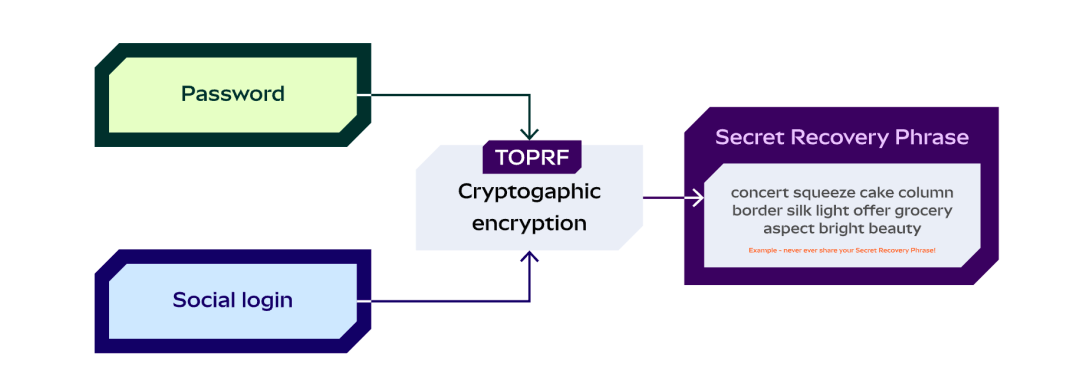
Tom Lee responds to X's debate with Fundstrat over differing bitcoin outlooks

Egrag Crypto: Selling XRP Now Makes No Sense. Here’s Why
What are Intent Based Architectures?
